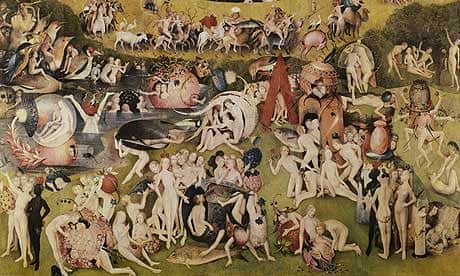Connoisseurs of early modern smut know that somewhere in Hieronymus Bosch's 16th-century Garden of Earthly Delights there is a nude figure with a posy of flowers sticking out of its bottom.
Those who visit the oil painting at Madrid's venerable Prado museum cannot always find the figure, however, among all the naked bodies and eye-popping torture scenes on the Dutch master's famous triptych.
For those who have gone away disappointed, however, help is finally at hand. Under an agreement unveiled with the Prado yesterday, the internet search engine company Google will deploy technology used by its Google Earth global mapping programme to hang a gigapixel gallery of Prado masterpieces on the internet.
With a resolution of 14,000 megapixels (or about 1,400 times the definition of a standard 10 megapixel camera) the images of the 14 Prado masterpieces are so precise that even the individual brushstrokes on Bosch's human flower pot can be seen. "You can see details that the human eye alone is unable to see," the museum said.
Armchair internet tourists are used to travelling the online globe generated by Google Earth's satellite and aerial photograph technology to visit exotic places or snoop on the homes of friends and relatives. As of yesterday they can also crawl all over masterpieces by the likes of Bosch, Francisco de Goya, Diego Velázquez, Peter Paul Rubens and Rembrandt.
Fourteen of the gallery's finest masterpieces can now be seen online in almost microscopic detail.
Velázquez's famous portrait of the family of Philip IV, Las Meninas, is among the works that can be viewed in the sort of detail that would otherwise require art lovers to glue their noses to the canvas. Even the stitching used to sew the vast canvas together is visible.
Other works include Goya's Third of May, Rubens's The Three Graces, and Titian's huge portrait The Emperor Charles V.
"These are 14 of the most important works in the museum," said the Prado's director, Miguel Zugaza.
People wanting to view the masterpieces must first download and install Google Earth. They need to enable the programme's 3D option and then travel to Madrid and click the button marking the Prado building.
The images were sewn together digitally from more than 8,000 high resolution photographs taken over six months.
Some of the masterpieces, such as the 3.3 by 2.8 metre portrait of Charles V, are so huge that it is impossible to get close enough to the original to see some details. "You would need a three-metre-high step-ladder," said Clara Rivera of Google, who thought up the idea of a gigapixel gallery.
With a few clicks of a mouse, she was able to show a minuscule wasp perched on a flower above the Three Graces and a crystal-clear teardrop in the eye of a figure in Rogier van der Weyden's Descent from the Cross.
Zugaza said that, among other things, he had used the images to check the quality of past restoration work.
He said the gigapixel gallery would be especially useful for complex paintings such as the Garden of Earthly Delights, which were hard to take in fully even after several visits.
He acknowledged, however, that a photographic image, however precise, could never replace the pleasure of contemplating an original painting.
"This shows you the body of the painting in almost scientific detail, but what you won't find here is the soul," he said.
"You can only find that by looking at the original."
Zugaza said the museum was developing educational material for teachers, students and researchers to go with the virtual gallery.
Google has no plans yet to extend the project to other museums or incorporate more of the Prado's 1,000-plus pictures.
For major galleries, however, the technology provides an opportunity to create internet annexes where they can display the hundreds of works they often have hidden away in storerooms.



